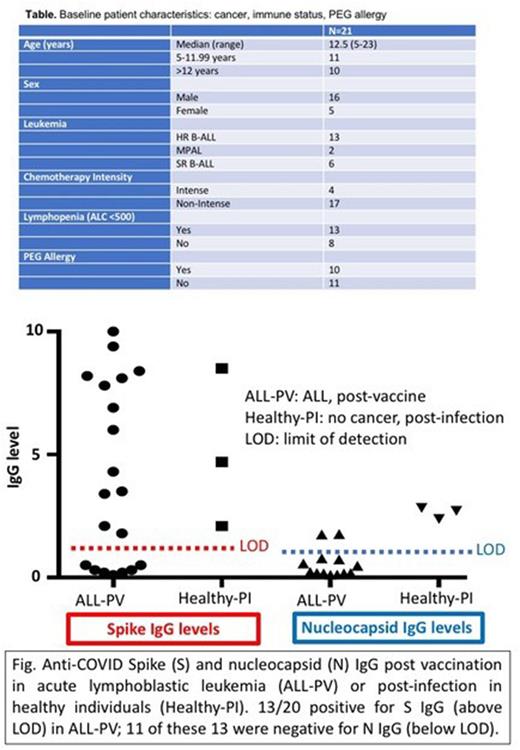Abstract
Background:While several studies have shown that less than half of adults on active therapy for chronic hematological malignancies develop an immune response to COVID-19 vaccination, little is known about the efficacy of COVID-19 vaccines in the midst of active therapy for acute lymphoblastic leukemia (ALL). Furthermore, COVID-19 vaccine outcomes in pediatric leukemia remain uncharacterized. Given the differences in the intensity of chemotherapy regimens between pediatric ALL and adult chronic hematological malignancies as well as age related immune differences, there is a need to specifically define vaccination outcomes in pediatric ALL. This study aims to define the safety and efficacy of COVID-19 vaccination in children and adolescents and young adults with ALL, the most common pediatric leukemia.
Methods: We conducted a prospective single center Institutional Review Board approved study. Eligible patients were ages 5-25 years with a diagnosis of ALL or receiving ALL-like therapy who had received COVID-19 vaccination. Pediatric oncology patients at our center undergo universal surveillance for COVID-19 via nasopharyngeal PCR regardless of symptom status, prior to any sedation or hospitalization. Labs were drawn at 3,6-, and 12-months post-vaccination for anti-COVID-19 spike (S) and nucleocapsid (N) IgG ELISA and anti S neutralizing antibody assays, in vitro COVID-19 peptide stimulation T-cell response studies, and T-cell receptor (TCR) sequencing for COVID specific TCR. These tests were validated in healthy COVID-19 infection convalescent and healthy post-vaccination cohorts.
Results: Between April 2021 and April 2022, the study enrolled 21 patients (median age 12.5 years). Diagnoses included high risk B-ALL (n=13), mixed-phenotype acute leukemia (MPAL) (n=2), and standard risk B-ALL (n=6). Three had relapsed ALL. All were in complete remission and receiving chemotherapy at the time of vaccination (17 receiving maintenance therapy and 4 in an intensive chemotherapy phase). Twenty received the BNT162b2 mRNA vaccine (10mcg dose n=11 and 30mcg dose, n=9); one received the Ad26.COV2.S vaccine. One patient received one dose (excluded from efficacy analysis), 17 received 2 doses, and 2 received three doses (i.e. a booster dose) of BNT162b2. Vaccinations were well tolerated with no patient experiencing anaphylaxis or an allergic reaction, including 10 patients with PEG-asparaginase allergy (BNT162b2 contains PEG). Three patients presented to the emergency department with fever; one of those was hospitalized for hypotension.
Thirteen of 20 patients (65%) were positive for spike (S) anti-COVID-10 IgG following two doses of BNT162b2 (n=12) or one dose of Ad26.COV2.S (n=1). Eleven of these 13 were negative for N IgG, an antibody profile (S IgG+, N IgG-) consistent with an immune response to vaccination rather than a prior undiagnosed COVID-19 infection. All three patients with ≥ 6 months post-vaccination data continue to be positive for S IgG. Notably, 6 of 12 lymphopenic patients (absolute lymphocyte count <500 at the time of vaccination) and 3 of 4 patients in an intense phase of therapy during vaccination showed an immune response. Six of 8 patients with PEG-allergy had an immune response. All patients with positive S IgG showed presence of neutralizing anti-S antibodies. There was no difference in immune response based on vaccine dose. Five of 20 patients (3 of 13 patients who were S IgG+ following vaccination) developed COVID-19 infection following vaccination; one of these occurred after the third dose. Hospitalization was needed in one of five cases of COVID-19. All infections occurred during the omicron wave and included 3 sequencing confirmed omicron infections (variant testing not done for 2).
Conclusions: In our study, two doses of COVID-19 vaccination induced a neutralizing antibody response in over half of the children and AYA actively receiving ALL chemotherapy including those who were receiving intensive chemotherapy or had PEG allergy. Adverse events were uncommon. Omicron infections occurred in our study, a finding consistent with the occurrence of breakthrough omicron variant infections in immunocompetent vaccinated individuals. T-cell response studies for our cohort are ongoing. Additional long-term follow-up and larger studies are needed to investigate durability of immune response and optimal vaccine frequency especially in the setting of omicron variants.
Disclosures
Pannaraj:Pfizer: Research Funding; Astrazeneca: Research Funding.
Author notes
Asterisk with author names denotes non-ASH members.


This feature is available to Subscribers Only
Sign In or Create an Account Close Modal